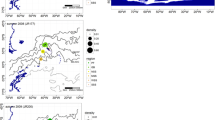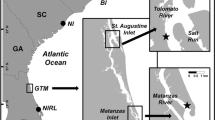Abstract
Most marine benthic macroinvertebrate species reproduce via a larval phase but attempts to explain the occurrence of different larval strategies (feeding or non-feeding, pelagic or benthic) in different habitats have been largely inconclusive. There have been very few year-round surveys of meroplankton at any latitude and in consequence fundamental data on the diversity, abundance, and timings of larval life history phases are lacking. There has been considerable debate regarding the viability of pelagic larvae in cold waters with highly seasonal primary production but there has been only one year-round study of meroplankton in the Southern Ocean, and that was outside of the Antarctic Circle. We present data from the first year-round survey of meroplankton assemblages at a location within the Antarctic Circle. We surveyed abundances of meroplanktonic larvae over 1.5 year at Rothera Point, West Antarctic Peninsula (67°34′S, 68°07′W). Larvae were collected in monthly diver-towed net samples close to the seabed at 20 and 6 m total water depths at each of three locations and were identified and counted live immediately after sampling. A total of 99 operationally defined taxonomic types representing 11 phyla were recorded but this is likely to be an underestimate of true diversity because of inherent difficulties of identification. Larvae were present in all months of the year and although planktotrophic larvae were more abundant in summer, both feeding and non-feeding types were present in all months. Comparisons of seasonal larval abundances with data from a settlement study at the same sites and from the literature show that larvae of mobile adults settle in summer regardless of developmental type, whereas sessile taxa settle in all seasons. We suggest that this is a consequence of differences in the food requirements of mobile and sessile fauna and that the availability of food for post-larval juveniles is more critical for survival than factors affecting the larval stage itself.








Similar content being viewed by others
References
Arnaud PM (1977) Adaptations within the Antarctic marine ecosystem. In: Llano GA (ed) Adaptations within Antarctic ecosystems. Proceedings of the third SCAR symposium on Antarctic biology. Smithsonian Institution, Washington
Barnes DKA, Clarke A (1995) Seasonality of feeding activity in Antarctic suspension feeders. Polar Biol 15:335–340
Barnes DKA, Clarke A (1998) The ecology of an assemblage dominant: the encrusting bryozoan Fenestrulina rugula. Invertebr Biol 117:331–340
Bosch I (1989) Reproduction and development of shallow-water asteroids and an echinoid in McMurdo Sound, Antarctica. PhD, University of California
Bosch I, Pearse JS (1990) Developmental types of shallow-water asteroids of Mcmurdo Sound, Antarctica. Mar Biol 104:41–46
Bosch I, Rivkin RB (1988) Feeding dynamics by planktotrophic asteroid larvae in oligotrophic environments. Am Zool 28:A167
Bosch I, Beauchamp KA, Steele ME, Pearse JS (1984) Slow developing feeding larvae of a common antarctic sea urchin reared through metamorphosis. Am Zool 24:A131
Bosch I, Beauchamp KA, Steele ME, Pearse JS (1987) Development, metamorphosis, and seasonal abundance of embryos and larvae of the antarctic sea urchin Sterechinus neumayeri. Biol Bull 173:126–135
Bowden DA (2005a) Quantitative characterisation of shallow marine benthic assemblages at Ryder Bay, Adelaide Island, Antarctica. Mar Biol 146:1235–1249
Bowden DA (2005b) Seasonality of recruitment in Antarctic sessile marine benthos. Mar Ecol Prog Ser 297:101–118
Bowden DA, Clarke A, Peck L, Barnes DKA (2006) Antarctic sessile marine benthos: colonisation and growth on artificial substrata over three years. Mar Ecol Prog Ser 316:1–16
Brand TE (1980) Trophic interactions and community ecology of the shallow-water marine benthos along the Antarctic peninsula. PhD, University of California
Brockington S (2001) The seasonal ecology and physiology of Sterechinus neumayeri (Echinodermata: echinoidea) at Adelaide Island, Antarctica. PhD, Open University
Brockington S, Clarke A, Chapman ALG (2001) Seasonality of feeding and nutritional status during the austral winter in the Antarctic sea urchin Sterechinus neumayeri. Mar Biol 139:127–138
Chia FS (1974) Classification and adaptive significance of developmental patterns in marine invertebrates. Thalassia Jugosl 10:121–130
Clarke A, Leakey RJG (1996) The seasonal cycle of phytoplankton, macronutrients, and the microbial community in a nearshore Antarctic marine ecosystem. Limnol Oceanogr 41:1281–1294
Clarke KR, Warwick RM (2001) Change in marine communities: an approach to statistical analysis, 2nd edn. PRIMER-E Ltd, Plymouth
Clarke A, Meredith MP, Wallace MI, Brandon MA, Thomas DN (2008) Seasonal and interannual variability in temperature, chlorophyll and macronutrients in northern Marguerite Bay, Antarctica. Deep Sea Res Part 2 Top Stud Oceanogr 55:1988–2006
Crisp DJ (1974) Energy relations of marine invertebrate larvae. Thalassia Jugosl 10:103–120
Fetzer I, Arntz WE (2008) Reproductive strategies of benthic invertebrates in the Kara Sea (Russian Arctic): adaptation of reproduction modes to cold water. Mar Ecol Prog Ser 356:189–202
Fraser KPP, Clarke A, Peck LS (2002) Feast and famine in Antarctica: seasonal physiology in the limpet Nacella concinna. Mar Ecol Prog Ser 242:169–177
Gallardo CS, Penchaszadch PE (2001) Hatching mode and latitude in marine gastropods: revisiting Thorson’s paradigm in the southern hemisphere. Mar Biol 138:547–552
Graham J, Branch GM (1985) Reproductive patterns of marine invertebrates. Oceanogr Mar Biol Annu Rev 23:373–398
Grange LJ (2006) Reproductive success in Antarctic marine invertebrates. PhD thesis, University of Southampton
Grange LJ, Tyler PA, Peck LS, Cornelius N (2004) Long-term interannual cycles of the gametogenic ecology of the Antarctic brittle star Ophionotus victoriae. Mar Ecol Prog Ser 278:141–155
Grange LJ, Tyler PA, Peck LS (2007) Multi-year observations on the gametogenic ecology of the Antarctic seastar Odontaster validus. Mar Biol 153:15–23
Hain S, Arnaud PM (1992) Notes on the reproduction of high-Antarctic mollusks from the Weddell Sea. Polar Biol 12:303–312
Hoegh-Guldberg O, Pearse JS (1995) Temperature, food availability, and the development of marine invertebrate larvae. Am Zool 35:415–425
Jablonski D, Lutz RA (1983) Larval ecology of marine benthic invertebrates—paleobiological implications. Biol Rev Camb Philos Soc 58:21–89
Kirkwood JM (1994) Zooplankton community dynamics and diel vertical migration in Ellis Fjord, Vestfold Hills, Antarctica. PhD thesis, Monash University
Levin LA, Bridges TS (1995) Pattern and diversity in reproduction and development. In: McEdward LR (ed) Ecology of marine invertebrate larvae. CRC Press, Boca Raton, pp 2–36
McEdward LR (1997) Reproductive strategies of marine benthic invertebrates revisited: facultative feeding by planktotrophic larvae. Am Nat 150:48–72
Mileikovsky SA (1971) Types of larval development in marine bottom invertebrates, their distribution and ecological significance: a re-evaluation. Mar Biol 10:193–213
Pace DA, Manahan DT (2007) Cost of protein synthesis and energy allocation during development of Antarctic sea urchin embryos and larvae. Biol Bull 212:115–129
Pearse JS (1965) Reproductive periodicities in several contrasting populations of Odontaster validus (Koehler), a common Antarctic asteroid. In: Llano GA (ed) Antarctic research series, vol 5, biology of the antarctic seas II. American Geophysical Union, Washington
Pearse JS (1986) Contrasting modes of reproduction by common shallow-water Antarctic invertebrates. Antarct J US 20:138–139
Pearse JS, Lockhart SJ (2004) Reproduction in cold water: paradigm changes in the 20th century and a role for cidaroid sea urchins. Deep Sea Res Part 2 Top Stud Oceanogr 51:1533–1549
Pearse JS, Bosch I, McClintock JB, Marinovic B, Britton R (1986) Contrasting tempos of reproduction by shallow-water animals in McMurdo sound, Antarctica. Antarct J US 21:182–184
Pearse JS, Bosch I, Pearse VB, Basch LV (1991a) Differences in feeding on algae and bacteria by temperate and Antarctic sea star larvae. Antarctic J US 26(5):170–172
Pearse JS, McClintock JB, Bosch I (1991b) Reproduction of Antarctic benthic marine invertebrates—tempos, modes, and timings. Am Zool 31:65–80
Pearse JS, Mooi R, Lockhart SJ, Brandt A (2009) Brooding and species diversity in the Southern Ocean: selection for brooders or speciation within brooding clades? In: Krupnik I, Lang MA, Miller SE (eds) Smithsonian at the poles: contributions to international polar year science. Smithsonian Institution, Washington, pp 181–196
Pechenik JA (1999) On the advantages and disadvantages of larval stages in benthic marine invertebrate life cycles. Mar Ecol Prog Ser 177:269–297
Peck LS (1993) Larval development in the Antarctic nemertean Parborlasia corrugatus (Heteronemertea, Lineidae). Mar Biol 116:301–310
Peck LS, Clarke A, Chapman AL (2006) Metabolism and development of pelagic larvae of Antarctic gastropods with mixed reproductive strategies. Mar Ecol Prog Ser 318:213–220
Peck LS, Powell DK, Tyler PA (2007) Very slow development in two Antarctic bivalve molluscs, the infaunal clam Laternula elliptica and the scallop Adamussium colbecki. Mar Biol 150:1191–1197
Poulin E, Boletzky Sv, Feral J-P (2001) Combined ecological factors permit classification of developmental patterns in benthic marine invertebrates: a discussion note. J Exp Mar Biol Ecol 257:109–115
Powell D (2001) The reproductive ecology of Antarctic free-spawning molluscs. PhD, University of Southampton
Reitzel AM, Miner BG, McEdward LR (2004) Relationships between spawning date and larval development time for benthic marine invertebrates: a modelling approach. Mar Ecol Prog Ser 280:13–23
Rivkin RB, Bosch I, Pearse JS, Lessard EJ (1986) Bacterivory—a novel feeding mode for asteroid larvae. Science 233:1311–1314
Seager JR (1979) Reproductive biology of the antarctic opisthobranch Philine gibba Strebel. J Exp Mar Biol Ecol 41:51–74
Sewell MA (2005) Examination of the meroplankton community in the south-western Ross Sea, Antarctica, using a collapsible plankton net. Polar Biol 28:119–131
Shilling FM, Bosch I (1994) Pre-feeding embryos of antarctic and temperate echinoderms use dissolved organic material for growth and metabolic needs. Mar Ecol Prog Ser 109:173–181
Shreeve RS, Peck LS (1995) Distribution of pelagic larvae of benthic marine invertebrates in the Bellingshausen Sea. Polar Biol 15:369–374
Stanwell-Smith D, Clarke A (1998a) Seasonality of reproduction in the cushion star Odontaster validus at Signy Island, Antarctica. Mar Biol 131:479–487
Stanwell-Smith D, Clarke A (1998b) The timing of reproduction in the Antarctic limpet Nacella concinna (Strebel, 1908) (Patellidae) at Signy Island, in relation to environmental variables. J Molluscan Stud 64:123–127
Stanwell-Smith D, Hood A, Peck LS (1997) A field guide to the pelagic invertebrate larvae of the maritime Antarctic. British Antarctic Survey, Cambridge
Stanwell-Smith D, Peck LS, Clarke A, Murray AWA, Todd CD (1999) The distribution, abundance and seasonality of pelagic marine invertebrate larvae in the maritime Antarctic. Philos Transact R Soc London Ser B Biol Sci 354:471–484
Strathmann RR (1985) Feeding and non-feeding larval development and life-history evolution in marine invertebrates. Annu Rev Ecol Syst 16:339–361
Thorson G (1936) The larval development, growth, and metabolism of arctic marine bottom invertebrates compared with those of other seas. Medd om Gronland 100:1–148
Thorson G (1946) Reproduction and larval development of Danish marine bottom invertebrates, with special reference to the planktonic larvae in the sound (Oresund). Meddr Kommn Danm Fisk og Havunders Ser Plankt 4:1–523
Thorson G (1950) Reproductive and larval ecology of marine bottom invertebrates. Biol Rev Camb Philos Soc 25:1–45
Todd CD, Doyle RW (1981) Reproductive strategies of marine benthic invertebrates—a settlement-timing hypothesis. Mar Ecol Prog Ser 4:75–83
Tyler PA, Reeves S, Peck L, Clarke A, Powell D (2003) Seasonal variation in the gametogenic ecology of the Antarctic scallop Adamussium colbecki. Polar Biol 26:727–733
Underwood AJ (1974) On models for reproductive strategy in marine benthic invertebrates. Am Nat 108:874–878
Vance RR (1973a) More on reproductive strategies in marine benthic invertebrates. Am Nat 107:353–361
Vance RR (1973b) On reproductive strategies in marine benthic invertebrates. Am Nat 107:339–352
Webb KE, Barnes DKA, Clark MS, Bowden DA (2006) DNA barcoding: a molecular tool to identify Antarctic marine larvae. Deep Sea Res Part 2 Top Stud Oceanogr 53:1053–1060
Wood LW (1985) Chloroform methanol extraction of chlorophyll a. Can J Fish Aquat Sci 3:8–43
Young CM (ed) (2002) Atlas of marine invertebrate larvae. Academic Press, London
Acknowledgments
We thank all in the marine team at Rothera from 2000 to 2003, particularly P. Horne, R. Piper, W. Gilchrist and J. Burleigh for diving and boating support. We are also grateful to J. Pearse and three anonymous reviewers for comments, which improved earlier drafts of the manuscript. This study formed part of the Life At The Edge; Stresses and Thresholds (LATEST) research programme of the British Antarctic Survey.
Author information
Authors and Affiliations
Corresponding author
Additional information
Communicated by A. Atkinson.
Rights and permissions
About this article
Cite this article
Bowden, D.A., Clarke, A. & Peck, L.S. Seasonal variation in the diversity and abundance of pelagic larvae of Antarctic marine invertebrates. Mar Biol 156, 2033–2047 (2009). https://doi.org/10.1007/s00227-009-1235-9
Received:
Accepted:
Published:
Issue Date:
DOI: https://doi.org/10.1007/s00227-009-1235-9




